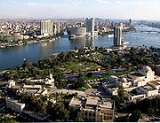
and the largest city in the Arab world
and Africa
, and the 16th largest metropolitan area in the world. Nicknamed "The City of a Thousand Minaret
s" for its preponderance of Islamic architecture
, Cairo has long been a centre of the region's political and cultural life. Cairo was founded by the Fatimid dynasty in the 10th century AD.; but the land composing the present-day city was the site of national capitals whose remnants remain visible in parts of Old Cairo
.
1945 The Arab League is founded when a charter is adopted in Cairo, Egypt.
1952 Black Saturday in Egypt: rioters burn Cairo's central business district, targeting British and upper-class Egyptian businesses.
1969 In Cairo, Yasser Arafat is appointed Palestine Liberation Organization leader at the Palestinian National Congress.
1985 Gunmen hijack EgyptAir Flight 648 while en route from Athens to Cairo. When the plane lands in Malta, Egyptian commandos storm the hijacked jetliner, but 60 people die in the raid.
1997 Hussein Aidid relinquishes the disputed title of President of Somalia by signing the Cairo Declaration, in Cairo, Egypt. It is the first major step towards reconciliation in Somalia since 1991.
1999 EgyptAir Flight 990 traveling from New York City to Cairo crashes off the coast of Nantucket, Massachusetts, killing all 217 on-board.

